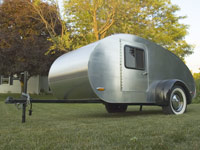 Thanks in advance, you guys have always been helpful.
Thanks in advance, you guys have always been helpful.How did you guys attach your bulkhead?
20 posts
• Page 1 of 2 • 1, 2
How did you guys attach your bulkhead?
More questions as I continue my build when I get home. How did you guys attach your bulkhead? I know that I will attach the bulkhead to my side walls from the outside in, that's a given. BUT, I was thinking of also attaching it to the floor, is this necessary? Here's the thing, my floor is sandwiched 1/4" ply, 1x2 nominal skeleton with insulation in the voids, 1/4" ply. Is it unnecessary to attach the bulkhead to the floor? especially since the floor is only 1/4" thick? depending on how far or away I move the bulkhead from the main cabin it may NOT be screwed to a skeleton crossmember of the floor and only through the 1/4 ply.  Thanks in advance, you guys have always been helpful.
Thanks in advance, you guys have always been helpful.
 Thanks in advance, you guys have always been helpful.
Thanks in advance, you guys have always been helpful.- 23Sojourney45
- Teardrop Advisor
- Posts: 90
- Images: 0
- Joined: Wed May 03, 2023 1:44 pm
- Location: California
Re: How did you guys attach your bulkhead?
Check out the countless build journals here. Most folks strategically install "nailers" in the wall and floor to screw the bulkhead into. It is imperative to clearly have the complete build sequence planned prior to building with dimensions. Many things will be very difficult to undo if they were not installed correctly.
-

Onajourney - Teardrop Master
- Posts: 259
- Images: 181
- Joined: Mon Sep 06, 2021 2:16 am
- Location: Central North Carolina




